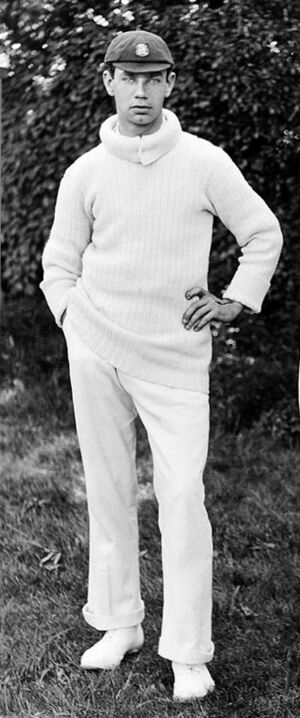Tiger Smith facts for kids

Smith in 1905
|
||||||||||||||||||||||||||||||||||||||||
| Personal information | ||||||||||||||||||||||||||||||||||||||||
|---|---|---|---|---|---|---|---|---|---|---|---|---|---|---|---|---|---|---|---|---|---|---|---|---|---|---|---|---|---|---|---|---|---|---|---|---|---|---|---|---|
| Born | 6 February 1886 Birmingham, Warwickshire, England |
|||||||||||||||||||||||||||||||||||||||
| Died | 31 August 1979 (aged 93) Northfield, Birmingham, England |
|||||||||||||||||||||||||||||||||||||||
| Batting | Right-handed | |||||||||||||||||||||||||||||||||||||||
| International information | ||||||||||||||||||||||||||||||||||||||||
| National side | ||||||||||||||||||||||||||||||||||||||||
| Test debut | 30 December 1911 v Australia | |||||||||||||||||||||||||||||||||||||||
| Last Test | 30 December 1913 v South Africa | |||||||||||||||||||||||||||||||||||||||
| Career statistics | ||||||||||||||||||||||||||||||||||||||||
|
||||||||||||||||||||||||||||||||||||||||
|
Source: CricInfo, 6 November 2022
|
||||||||||||||||||||||||||||||||||||||||
Ernest James "Tiger" Smith (born February 6, 1886 – died August 31, 1979) was a famous English cricketer. He was a skilled wicket-keeper, which means he was the player behind the stumps who catches the ball. Tiger Smith played in 11 important international matches called Test matches for England. He also had a very long career playing for his county team, Warwickshire, until 1930. After he stopped playing, he became a cricket umpire and even oversaw several Test matches. Later, he became a coach.
Contents
Who Was Tiger Smith?
Tiger Smith was a talented cricketer known for his excellent wicket-keeping skills. He was also a good batsman, scoring many runs for his team. His career spanned many years, first as a player, then as an umpire, and finally as a coach. He was a true legend in English cricket.
Early Life and Cricket Start
Tiger Smith was born in Birmingham, England. Before becoming a professional cricketer, he worked for the Cadbury chocolate company. In 1904, he joined the Warwickshire cricket team. For a few years, he didn't play very often because another great wicket-keeper, Dick Lilley, was already on the team.
Becoming a Star Wicket-Keeper
When Dick Lilley decided to focus more on batting, Tiger Smith got his chance. In 1910, his first full season, he played very well. He formed a great partnership with bowler Frank Foster.
The next year, 1911, was amazing for Warwickshire. They won the County Championship, which is a big cricket competition in England. The weather was very dry and hot that year, which helped fast bowlers like Foster and Frank Field. Smith was an incredible wicket-keeper, even standing close to the stumps when Foster was bowling very fast. He also improved a lot at batting. Before 1911, he had never scored 50 runs in a single game. But in 1911, he scored over 800 runs and even made a century (100 runs) against Surrey.
Playing for England
Because of his great performance, Tiger Smith was chosen to play for England in the 1911/1912 Ashes tour in Australia. This was a bit of a surprise to some people. However, his skill at catching balls from Frank Foster was so good that he kept another strong wicket-keeper, Herbert Strudwick, out of the Test team.
During that tour, Smith made eight catches and one amazing stumping (getting a batsman out by hitting the stumps with the ball). He was also excellent at handling the tricky bowling of Sydney Barnes. In 1912, England played in a special tournament, but the summer was very wet, which changed how cricket was played. Warwickshire's team didn't do as well, but Smith kept his good form. In 1913, he made 68 dismissals (getting batsmen out), which was his personal best. This led to him being chosen for a tour of South Africa. However, he only played one Test match there before losing his spot to Strudwick. He never played for England again after that.
Life After International Cricket
Even though he didn't play for England anymore, Tiger Smith remained a key player for Warwickshire. He played for them until he retired at the end of 1930. During these years, he continued to be a very consistent wicket-keeper. He also became an even better batsman. In 1922, he scored 1,303 runs. In 1925, he scored 1,477 runs, averaging over 31 runs per innings. That season, he scored a brilliant 139 runs without being out against Sussex.
A New Role: Umpire and Coach
After retiring as a player, Tiger Smith became a first-class cricket umpire in May 1931. He continued in this role until World War II began. He was an umpire in eight Test matches in England. His first Test as an umpire was in July 1933, between England and West Indies. He also umpired matches involving South Africa, New Zealand, and Australia.
After the war, Tiger Smith became the coach for Warwickshire. He held this position until the end of 1955. During his time as coach, Warwickshire won their second County Championship in 1951. He also umpired a few more first-class matches until 1953, mostly for Warwickshire against non-county teams. He continued to supervise a local indoor cricket school until the early 1970s, when he finally passed on his duties to younger people.
Legacy of a Cricket Legend
Tiger Smith was known for his strong fighting spirit, both on and off the cricket field. He also had a great sense of humor, which made him very popular throughout his long connection with cricket. When he passed away in 1979, Tiger Smith was the oldest living Test cricketer. He was also the last surviving player who had played Test cricket before World War I.

